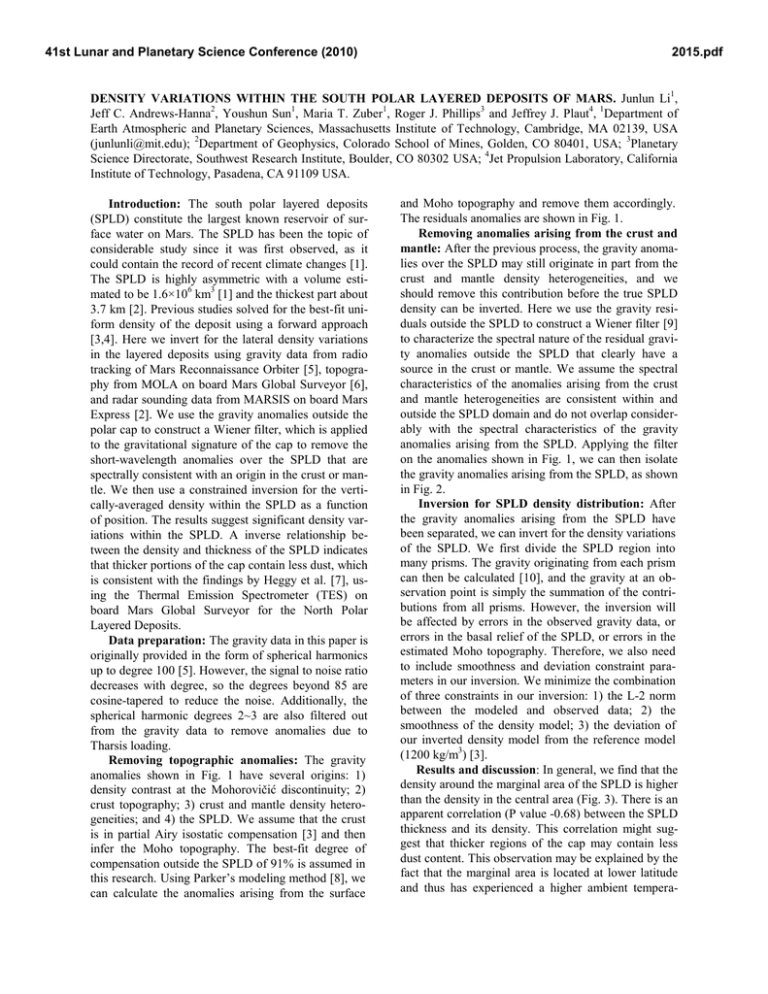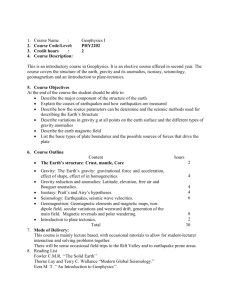DENSITY VARIATIONS WITHIN THE SOUTH ... , Jeff C. Andrews-Hanna , Youshun Sun
advertisement

41st Lunar and Planetary Science Conference (2010) 2015.pdf DENSITY VARIATIONS WITHIN THE SOUTH POLAR LAYERED DEPOSITS OF MARS. Junlun Li1, Jeff C. Andrews-Hanna2, Youshun Sun1, Maria T. Zuber1, Roger J. Phillips3 and Jeffrey J. Plaut4, 1Department of Earth Atmospheric and Planetary Sciences, Massachusetts Institute of Technology, Cambridge, MA 02139, USA (junlunli@mit.edu); 2Department of Geophysics, Colorado School of Mines, Golden, CO 80401, USA; 3Planetary Science Directorate, Southwest Research Institute, Boulder, CO 80302 USA; 4Jet Propulsion Laboratory, California Institute of Technology, Pasadena, CA 91109 USA. Introduction: The south polar layered deposits (SPLD) constitute the largest known reservoir of surface water on Mars. The SPLD has been the topic of considerable study since it was first observed, as it could contain the record of recent climate changes [1]. The SPLD is highly asymmetric with a volume estimated to be 1.6×106 km3 [1] and the thickest part about 3.7 km [2]. Previous studies solved for the best-fit uniform density of the deposit using a forward approach [3,4]. Here we invert for the lateral density variations in the layered deposits using gravity data from radio tracking of Mars Reconnaissance Orbiter [5], topography from MOLA on board Mars Global Surveyor [6], and radar sounding data from MARSIS on board Mars Express [2]. We use the gravity anomalies outside the polar cap to construct a Wiener filter, which is applied to the gravitational signature of the cap to remove the short-wavelength anomalies over the SPLD that are spectrally consistent with an origin in the crust or mantle. We then use a constrained inversion for the vertically-averaged density within the SPLD as a function of position. The results suggest significant density variations within the SPLD. A inverse relationship between the density and thickness of the SPLD indicates that thicker portions of the cap contain less dust, which is consistent with the findings by Heggy et al. [7], using the Thermal Emission Spectrometer (TES) on board Mars Global Surveyor for the North Polar Layered Deposits. Data preparation: The gravity data in this paper is originally provided in the form of spherical harmonics up to degree 100 [5]. However, the signal to noise ratio decreases with degree, so the degrees beyond 85 are cosine-tapered to reduce the noise. Additionally, the spherical harmonic degrees 2~3 are also filtered out from the gravity data to remove anomalies due to Tharsis loading. Removing topographic anomalies: The gravity anomalies shown in Fig. 1 have several origins: 1) density contrast at the Mohorovičić discontinuity; 2) crust topography; 3) crust and mantle density heterogeneities; and 4) the SPLD. We assume that the crust is in partial Airy isostatic compensation [3] and then infer the Moho topography. The best-fit degree of compensation outside the SPLD of 91% is assumed in this research. Using Parker’s modeling method [8], we can calculate the anomalies arising from the surface and Moho topography and remove them accordingly. The residuals anomalies are shown in Fig. 1. Removing anomalies arising from the crust and mantle: After the previous process, the gravity anomalies over the SPLD may still originate in part from the crust and mantle density heterogeneities, and we should remove this contribution before the true SPLD density can be inverted. Here we use the gravity residuals outside the SPLD to construct a Wiener filter [9] to characterize the spectral nature of the residual gravity anomalies outside the SPLD that clearly have a source in the crust or mantle. We assume the spectral characteristics of the anomalies arising from the crust and mantle heterogeneities are consistent within and outside the SPLD domain and do not overlap considerably with the spectral characteristics of the gravity anomalies arising from the SPLD. Applying the filter on the anomalies shown in Fig. 1, we can then isolate the gravity anomalies arising from the SPLD, as shown in Fig. 2. Inversion for SPLD density distribution: After the gravity anomalies arising from the SPLD have been separated, we can invert for the density variations of the SPLD. We first divide the SPLD region into many prisms. The gravity originating from each prism can then be calculated [10], and the gravity at an observation point is simply the summation of the contributions from all prisms. However, the inversion will be affected by errors in the observed gravity data, or errors in the basal relief of the SPLD, or errors in the estimated Moho topography. Therefore, we also need to include smoothness and deviation constraint parameters in our inversion. We minimize the combination of three constraints in our inversion: 1) the L-2 norm between the modeled and observed data; 2) the smoothness of the density model; 3) the deviation of our inverted density model from the reference model (1200 kg/m3) [3]. Results and discussion: In general, we find that the density around the marginal area of the SPLD is higher than the density in the central area (Fig. 3). There is an apparent correlation (P value -0.68) between the SPLD thickness and its density. This correlation might suggest that thicker regions of the cap may contain less dust content. This observation may be explained by the fact that the marginal area is located at lower latitude and thus has experienced a higher ambient tempera- 41st Lunar and Planetary Science Conference (2010) ture, which resulted in more ice sublimating and higher dust residuals. In comparison, Heggy et al. [7] found the marginal area of North Polar Layered Deposits (NPLD) has a higher concentration of surface dust from the observation of Thermal Emission Spectrometer (TES). If their assumption that the thermal inertia does not change significantly in depth is valid, both approaches indicate that the marginal areas of PLDs have higher density than their central areas. Additionally, we observe the highest densities in the northwest part of the SPLD, and also the gravity residuals are higher outside the cap in that direction (Fig. 4). The overlap of the higher gravity residuals outside the cap with the Dorsa Argentea formation (DAF) suggests that the highest SPLD densities in the northwest may also be explained in part by the possible extension of the DAF beneath the cap. Carr [1] suggests that the DAF is actually an ancient, ice-rich polar deposit, analogous to the deposits that are at the pole today, and the numerous pits on DAF are considered as an evidence of basal melting of the ground ice [11,12,13,14,15]. They also noticed the presence of small volcanoes in that area, and their existence provides direct evidence a connection between volcanism and the pits. The presence of volcanoes in this area suggests that the magma intrusion exists in the crust, and this intrusion underneath the DAF provides a high density contrast against the surrounding area. Therefore, our observed positive anomalies in the northwest part of SPLD and outside this area can be explained. References: [1] M. Carr (2006) Surface of Mars, Cambridge Univ. Press. [2] J.J. Plaut et al. (2007) Science, 316, 92-95. [3] M.T. Zuber et al. (2007) Science, 317, 17181719. [4] M.A. Wieczorek (2008) Icarus, 196, 506-517. [5] M.T. Zuber et al. (2007) JGR 112, E05S07. [6] D.E. Smith et al. (2001) JGR, 106, 23689-23722. [7] E. Heggy et al. (2008) LPS, 39, 2471. [8] R.L. Parker (1972) GJRAS. 31, 447-454. [9] R.S. Pawlowski and R.O. Hansen (1990) Geophysics, 55, 539-548. [10] P. Rama Rao et al. (1999) Comp. & Geo., 25, 887-896. [11] J.W. Head and S. Pratt (2001) JGR, 106, 12275-12299. [12] G.J. Ghatan et al. (2003) JGR, 108(E5), 5045. [13] G.J. Ghatan and J.W. Head (2002) JGR, 107(E7). [14] G.J. Ghatan and J.W. Head (2004) JGR, 109, E07006. [15] S.M. Milkovich et al. (2002) JGR, 107, E06007. 2015.pdf Fig. 1. Residual gravity anomalies after removing the surface and Moho topographic effects. Fig. 2. Gravity anomalies associated with the SPLD after applying the Wiener filter. Fig. 3. Density variation of the SPLD. Fig 4. Gravity residuals in the SPLD region.




